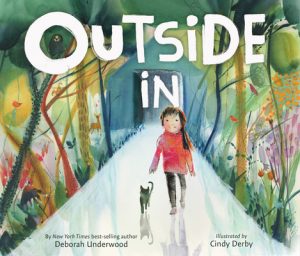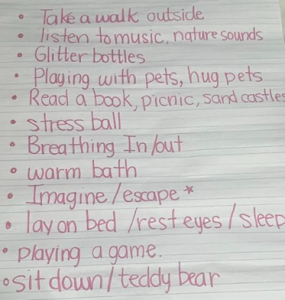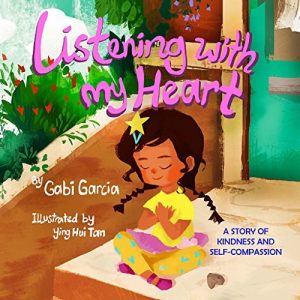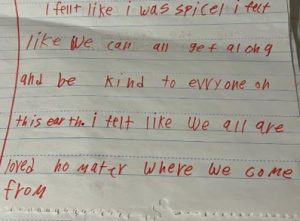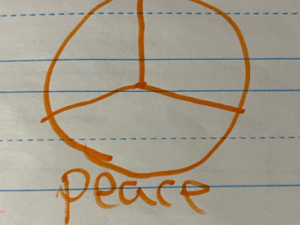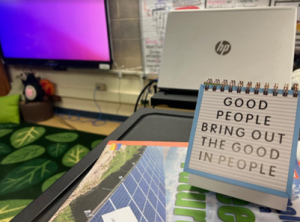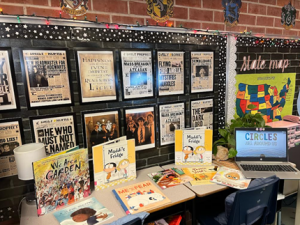By Angelica Serrano, 4th Grade Teacher with Jennifer Carey, School Counselor, Van Buskirk School, Tucson, Arizona
James Comer, a leading child psychiatrist once said, “No significant learning occurs without a significant relationship.” – Kyle Schwartz
As a class, we discovered a certain connectedness, a bridge between each of us by exploring the activity “I wish My Teacher Knew…” The activity opened the door for our fourth-grade class to continue to have these conversations as our circles expanded and we realized just how much we each experience outside of the classroom. Now I wondered: how do we internalize this conversation and move forward? This is where we launched our second exploration with another children’s book.
We regrouped the following day and read the text Outside In by Deborah Underwood. Since students resonated with the idea that we can create circles to open spaces for others to be a part of us, I began to consider ways that encouraged students to invite the outside world into their inner spaces. Through this second read aloud our critical discussion focused on strategies for regulating our emotions and appreciating nature. Students realized that connecting with the world and immersing ourselves with nature kept us grounded. For example, one student offered this comment – “I think that going outside and taking some deep breaths can really help us.” “We can also listen to music,” another student added, “or hug our pets” someone else stated. We created a list of self -regulatory strategies.
At that moment, a student from another classroom entered our room for a brief “time out” from her classroom. This student listened attentively to our discussions. We paired the text Outside In with another book Listening With My Heart: A Story of Kindness and Self-Compassion by Gabi Garcia. As I read the text, our room fell silent. Students listened attentively and clapped at the end of the text. “I wish we could do more lessons like this,” a student shared, and I saw nods across the room. As an educator that statement hit me hard. It made me realize how much students were impacted by the pandemic because for about two years they had been isolated, feeling lonely, grieving a loss, or going through some sort of hardship. Because they had limited interactions with peers, it became difficult for them to socialize when they came back to the classroom.
My current 4th graders were in 2nd grade when the pandemic began, and school shifted to virtual learning. This shift caused long-term social emotional struggles for children and teachers. During the pandemic when students engaged with the outside world, they were forced to wear masks and therefore were unable to see facial expressions or body language, a vital form of communication at such a young age. When students were forced to learn virtually, they missed key social interactions.
Following these two read alouds, students took time to respond by completing a graffiti board. In small groups, they discussed and shared emotions once again, feeling empathy for others, admitted to feeling sad about their struggles, as well as learning about love and how we can help others and ourselves.
The girl who visited our room for a small time out approached me in tears, telling me she felt bad for how she treated her classmates prior to arriving in my room. Her comment was a reminder that this social emotional work is important not just for students but for educators too.
Students took action immediately in the following days. We have a classroom bear, our comfort buddy Mr. Oso, to use whenever we feel sad, lonely, angry or upset. Students embraced Mr. Oso and others brought in supplies to use for our designated Calm Corner area in our room, such as glitter bottles, pop-its, and stress balls. Another student brought in a daily quote book. She picked out the quote: “Good people bring out the good in people” to display in the front of our room, just a little reminder of a mantra we can focus on for the day.
The students reminded me that creating spaces for social emotional learning is vital. Students need spaces for community building, reflection, and learning about strategies they can use and incorporate to socialize with others and regulate their emotions in a healthy manner. Through this interaction we were able to understand each other, create a space for empathy and kindness, as well as nurture our mindfulness of how we feel and how others feel.
Our work became a team effort on behalf of students, our school counselor, and me. In fact, this project could not have been done without the support of our school counselor Ms. Jennifer Carey who states:
“As an elementary school counselor, I use a story with almost all of my counseling lessons. I have a library of books to support social emotional learning in my office for all students to access. These books are read in my small groups and also during individual student meetings. For students experiencing a significant loss, I often bring out The Goodbye Book, by Todd Parr. During the COVID-19 pandemic, we were experiencing many losses on our campus. I reached out to the author and his publishing company; they generously donated 20 signed hardback copies for me to give to students who lost a loved one that year. It’s such a comforting book where most students often identify with every page. SEL literature enhances my counseling program tremendously.” Jennifer Carey, School Counselor, Van Buskirk Elementary
I invite you to work with your school librarian, fellow educators, families, and school counselors to find ways for incorporating books as well as critical discussions into your daily routines, ones that bring the “outside in” and move the inward outward as we open our circles to infinite possibilities.
Our critical conversations have not stopped. We have planned more opportunities for reading various books and discussions that specifically allow us to address empathy and kindness. The following texts are a sampling of upcoming read alouds and critical discussions:
- Wemberly Worried by Kevin Henkes (2000)
- Hurty Feelings by Helen Lester (2004)
- Those Shoes by Maribeth Boelts (2007)
- Maddie’s Fridge by Lois Brandt (2014)
- Me and My Fear by Francesca Sanna (2018)
- A Book of Love by Emma Randall (2019)
- B is for Breathe: The ABC’s of Coping with Fussy and Frustrating Feelings by Dr. Melissa Muhro Boyd (2019)
- The Good Egg by Jory John and Pete Oswald (2019)
- We Are a Garden by Lisa Westberg Peters & Victoria Tentler-Krylov (2021)
- A Perfect Fit: How Lena “Lane” Bryant Changed the Shape of Fashion by Juana Martinez-Neal (2022)
- I Don’t Care by Juana Martinz-Neal (2022)
Slowly I am realizing how the pandemic impacted my students and me. These critical conversations expand my social emotional learning as a person and educator.
Remember you are not alone; we are all a part of this world together and it is only together that we can strive to make the world a better place. As we start a new year, I encourage you to do the same; it is never too late to have these conversations with students and create these vital spaces.
WOW Currents is a space to talk about forward-thinking trends in global children’s and adolescent literature and how we use that literature with students. “Currents” is a play on words for trends and timeliness and the way we talk about social media. We encourage you to participate by leaving comments and sharing this post with your peers. To view our complete offerings of WOW Currents, please visit its archival stream.
- Themes: Angelica Serrano, Deborah Underwood, Gabi Garcia, Jennifer Carey, Listening With My Heart, Outside In
- Descriptors: Books & Resources, WOW Currents

